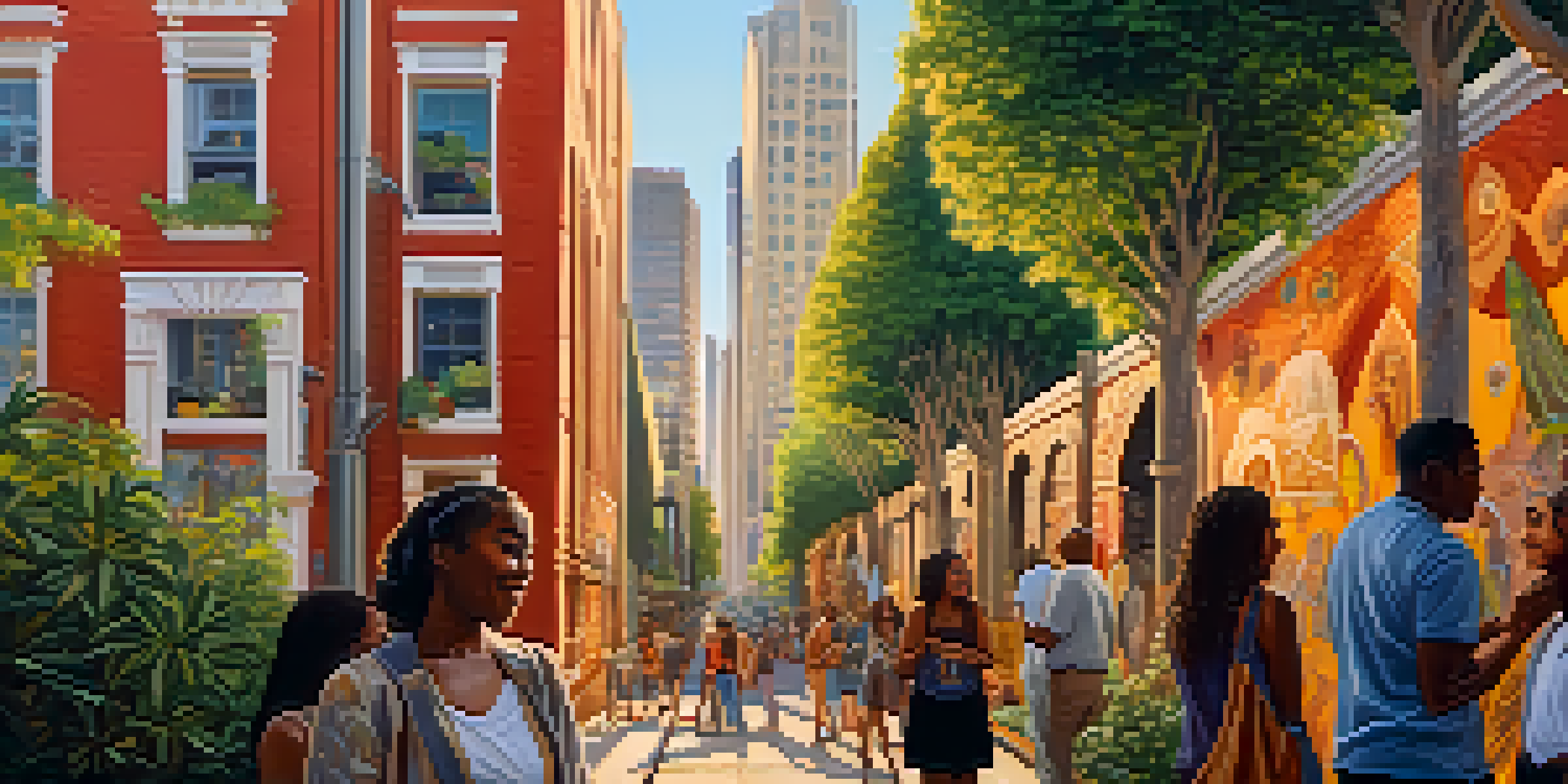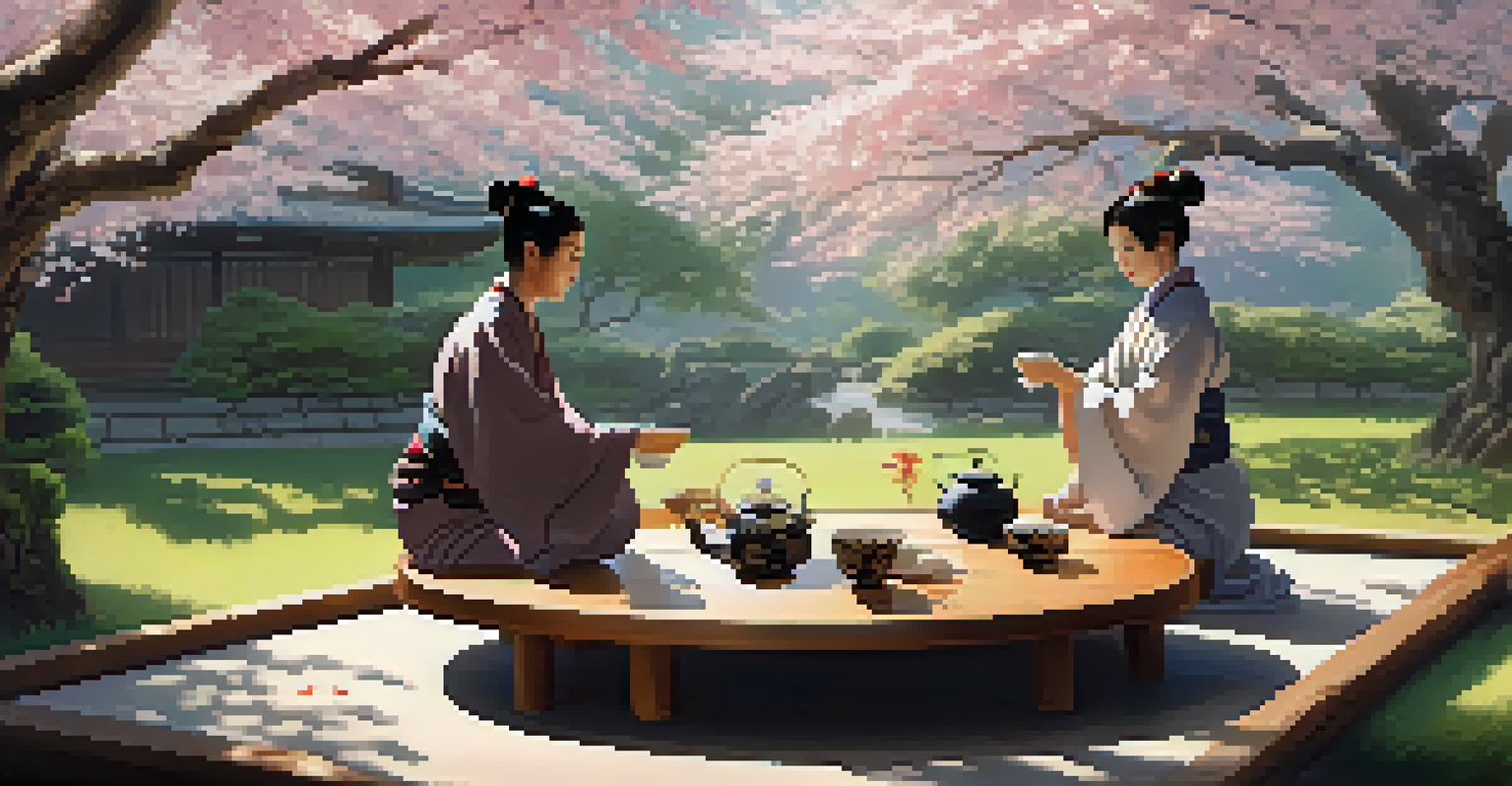Art as a Reflection of Civic Identity in Global Cities

Understanding Civic Identity in a Global Context
Civic identity refers to the shared sense of belonging and community among residents of a city. It encompasses the values, beliefs, and customs that define a place and its people. In a globalized world, cities are melting pots of diverse cultures, making the exploration of civic identity all the more intriguing.
Art is the most beautiful of all lies; it is a bridge between the world of dreams and the world of reality.
As cities grow and evolve, their civic identities often shift, influenced by migration, economic changes, and social movements. Art becomes a powerful lens through which we can examine these changes, illustrating the stories and experiences of various communities. By understanding civic identity, we can better appreciate how art reflects and shapes our shared urban experiences.
For example, street art in cities like Berlin often tells the stories of its residents, showcasing their struggles and triumphs. This dialogue between art and civic identity is essential for fostering a sense of belonging and community pride.
The Role of Public Art in Urban Spaces
Public art serves as a visual representation of a city's identity, transforming urban landscapes into vibrant cultural hubs. From murals and sculptures to installations and performances, public art engages residents and visitors alike. This accessibility makes art a critical medium for expressing civic pride and identity.

Consider the famous 'Love Park' in Philadelphia, where public art installations invite interaction and reflection. Such spaces not only enhance the aesthetic appeal of the city but also encourage conversations about local history and shared values. As a collective expression, public art can spark dialogue and foster community connections.
Civic Identity Shapes Community Art
Civic identity, influenced by diverse cultures and social movements, is reflected and shaped through various forms of art in urban spaces.
Moreover, public art often addresses social issues, giving voice to marginalized communities. By highlighting these perspectives, artists can prompt residents to reflect on their civic responsibilities and the importance of inclusivity in urban life.
Art Festivals: Celebrating Local Civic Identity
Art festivals are powerful events that celebrate local culture and civic identity, bringing together artists and communities. These gatherings create opportunities for dialogue, collaboration, and appreciation of diverse artistic expressions. They also attract visitors, enhancing the city’s cultural tourism and economy.
Public art is a way of bringing art into the lives of ordinary people and making it accessible to everyone.
For instance, the Venice Biennale showcases contemporary art from around the world while simultaneously highlighting Venetian culture. Such events not only elevate local artists but also invite global perspectives, enriching the civic identity of the host city. They create a platform for discussing pressing social issues and celebrating community achievements.
By participating in art festivals, residents engage with their city's identity, forming connections with both their immediate community and the broader global art scene. This interaction fosters a sense of pride and belonging, reinforcing civic identity in a vibrant and dynamic way.
Art as a Catalyst for Social Change
Throughout history, art has played a significant role as a catalyst for social change, challenging the status quo and inspiring action. In many global cities, artists use their work to address pressing social issues, from inequality to environmental concerns. This advocacy not only reflects civic identity but also shapes it in meaningful ways.
For example, the powerful murals in Los Angeles highlight the struggles of marginalized communities, pushing for awareness and change. These artistic expressions serve as a call to action, encouraging citizens to engage with the issues affecting their lives and communities. Art becomes a vehicle for dialogue, urging both reflection and response.
Public Art Fosters Community Pride
Public art serves as a visual representation of a city's identity, encouraging engagement and dialogue among residents and visitors.
By amplifying voices that are often overlooked, artists contribute to a more inclusive civic identity. Their work invites residents to envision a shared future, one that prioritizes equity, justice, and community engagement.
The Influence of Cultural Heritage on Civic Identity
Cultural heritage is a cornerstone of civic identity, shaping the narratives and values of a city. Art plays an essential role in preserving and celebrating this heritage, creating a sense of continuity and belonging among residents. From traditional crafts to contemporary expressions, the relationship between art and cultural heritage is vital.
Take the example of Kyoto, where traditional Japanese art forms, such as calligraphy and tea ceremonies, are celebrated alongside modern artistic expressions. This blend of old and new fosters a rich cultural tapestry, allowing residents to connect with their past while embracing the future. The preservation of cultural heritage through art reinforces a city's unique identity.
As cities navigate globalization, the challenge lies in balancing the preservation of cultural heritage with the integration of diverse artistic influences. By promoting cultural heritage through art, cities can cultivate a strong civic identity that honors the past while looking toward a shared future.
Art and Civic Engagement: Building Community Connections
Art has the unique ability to bring people together, fostering civic engagement and strengthening community bonds. Through collaborative art projects, residents can connect with one another, share their stories, and contribute to the collective identity of their city. This engagement enhances the sense of belonging and ownership among residents.
For instance, community mural projects in cities like Detroit allow residents to work together, creating a visual representation of their shared experiences and aspirations. Such initiatives not only beautify urban spaces but also empower residents to take an active role in shaping their environment. This sense of agency is crucial for building a cohesive civic identity.
Art Drives Social Change and Unity
Art acts as a powerful vehicle for social change, amplifying marginalized voices and fostering civic engagement within communities.
Furthermore, inclusive art programs can bridge divides between different cultural and socioeconomic groups. By encouraging collaboration and dialogue, art can help cultivate understanding and empathy, ultimately enriching the civic identity of a city.
The Future of Art and Civic Identity in Global Cities
As cities continue to evolve, the relationship between art and civic identity will undoubtedly transform. Emerging technologies, such as digital art and virtual reality, offer new avenues for artistic expression and engagement. These innovations will shape how residents experience and connect with their city's identity.
Moreover, as global challenges like climate change and social inequality become more pressing, artists will continue to play a vital role in raising awareness and inspiring action. Their work will reflect the values and concerns of their communities, shaping civic identity in response to these challenges.

Ultimately, the future of art and civic identity in global cities lies in the continued collaboration between artists, residents, and local governments. By fostering creative dialogue and prioritizing inclusivity, cities can cultivate vibrant civic identities that reflect the diverse voices of their communities.